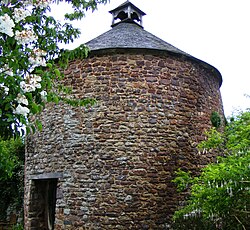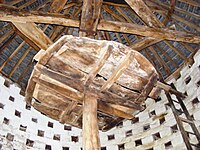Dunster Dovecote: Difference between revisions
Created page with "{{Infobox building |name=Dunster Dovecote |county=Somerset |village=Dunster |picture=Dunster Dovecote.JPG |picture caption=Dunster Dovecote |os grid ref=SS98944376 |latitude=5..." |
m →top: ioe -> nhle, replaced: {{IoE|264714 → {{NHLE|1057581 |
||
| Line 21: | Line 21: | ||
The priory was abolished in the dissolution of the monasteries in 1539, and property belonging to it was sold to the Luttrell family of [[Dunster Castle]]. | The priory was abolished in the dissolution of the monasteries in 1539, and property belonging to it was sold to the Luttrell family of [[Dunster Castle]]. | ||
The Dunster Dovecote has been designated as a Grade II* listed building and Scheduled Ancient Monument.<ref name=IoE>{{ | The Dunster Dovecote has been designated as a Grade II* listed building and Scheduled Ancient Monument.<ref name=IoE>{{NHLE|1057581|Dovecote, Dunster}}</ref> | ||
[[File:Dunster Dovecote interior.JPG|left|thumb|200px|The interior showing the feeding platform, ladder and nest holes]] | [[File:Dunster Dovecote interior.JPG|left|thumb|200px|The interior showing the feeding platform, ladder and nest holes]] | ||
Latest revision as of 07:13, 19 September 2019
| Dunster Dovecote | |
|
Somerset | |
|---|---|
 Dunster Dovecote | |
| Type: | Dovecote |
| Location | |
| Grid reference: | SS98944376 |
| Location: | 51°11’1"N, 3°26’46"W |
| Village: | Dunster |
| History | |
| Built 16th century | |
| Dovecote | |
| Information | |
| Owned by: | Dunster Parochial Church Council |
The Dunster Dovecote stands on Priory Green opposite the Tithe Barn in Dunster, Somerset, close to the walls of the Priory Church of St George. The dovecote was probably built in the late 16th century.
Standing approximately 19 feet high and 19 feet in diameter,[1] with walls around four feet thick,[2] this is a substantial dovecote. It has five hundred and forty nest-holes.[1]
There is no documentary evidence for the dovecote's date of construction but it some of the architectural features suggest it may have been as long ago as the 14th century. It would originally have provided meat for the tables of the Benedictine Priory of Dunster which was a cell of Bath Abbey. From the 12th century until 1619, only lords of the manor and parish priests were allowed to keep pigeons for the table.
The priory was abolished in the dissolution of the monasteries in 1539, and property belonging to it was sold to the Luttrell family of Dunster Castle.
The Dunster Dovecote has been designated as a Grade II* listed building and Scheduled Ancient Monument.[3]

In the 18th century the floor level and door were raised among several major alterations. The lower tiers of nest holes were blocked to protect against brown rats which had arrived in the Britain in 1720 and reached Somerset by 1760. A revolving ladder, known as a "potence", was installed in the 16ht century, secured on a pin driven into a beam in the floor, to allow the pigeon keeper to search the nest holes more easily. In the 19th century two feeding platforms were added to the axis of the revolving ladder.[4] The head of the pin supporting the ladder sits in a metal cup in the base of the wooden pillar, which means the mechanism has never had to be oiled.[5]
When the Dunster Castle estate was sold the dovecote was bought by the parochial church council and opened to the public. Extensive repairs were undertaken in 1989.
References
- ↑ 1.0 1.1 Cooke, A.O.: Book of Dovecotes, Chapter 17: Somerset and Devon
- ↑ Ballard, Barbara. "Dunster Somerset". Britain Express. http://www.britainexpress.com/villages/dunster.htm. Retrieved 2009-06-04.
- ↑ National Heritage List 1057581: Dovecote, Dunster
- ↑ "Dovecote, Dunster". Somerset Historic Environment Record. Somerset County Council. http://webapp1.somerset.gov.uk/her/details.asp?prn=34618. Retrieved 2009-06-04.
- ↑ Byford, Enid (1987). Somerset Curiosities. Dovecote Press. p. 93. ISBN 0946159483.